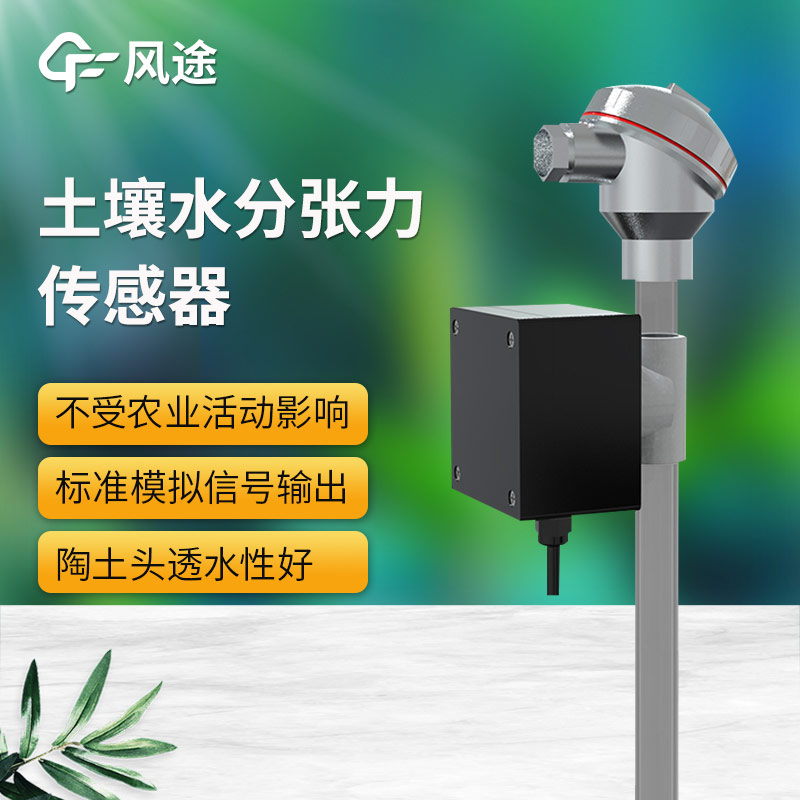Shandong Fengtu IOT Technology Co., Ltd
Sales Manager:Ms. Emily Wang
Cel,Whatsapp,Wechat:+86 15898932201
Email:info@fengtutec.com
Add:No. 155 Optoelectronic Industry Accelerator, Gaoxin District, Weifang, Shandong, China

Sales Manager:Ms. Emily Wang
Cel,Whatsapp,Wechat:+86 15898932201
Email:info@fengtutec.com
Add:No. 155 Optoelectronic Industry Accelerator, Gaoxin District, Weifang, Shandong, China
time:2024-05-28 08:39:35 source:Weather Station viewed:327 time
Today we introduce a soil sensor - water potential sensor.
The concept of soil water potential:
The total soil water potential consists of four elements: gravity, pressure, matrix and infiltration. In unsaturated soils, the soil matrix potential is particularly important and reflects the suction and capillary action of the soil matrix. Matrix potential is expressed in kilopascals or centimetres of water column and has a negative value, as opposed to soil suction. Soil tensiometers are commonly used as measuring tools, but the range and automation of the measurements are limited. So then came the soil water potential sensor.
It uses a transparent PVC pipe for easy observation of water volume and easy replenishment. Equipped with a -100 to 0Kpa vacuum gauge for easy reading. It is suitable for monitoring soil moisture and drought conditions, especially in agricultural cultivation to help determine whether crops need irrigation. When the PVC pipe is filled with water and inserted into the soil, the soil will absorb some of the water, resulting in negative pressure inside the pipe. The greater the negative pressure value, the greater the ability of the soil to absorb water, meaning the drier the soil.
How to install?
1. Prepare cool boiled water by boiling tap water for 20 minutes, cool it down and set it aside.
2. Fill the clay head with cool boiled water and stand it upright for 10 to 40 minutes, uncovered, until the water drips off the surface. Seal with a silicone plug and blot dry with paper towel to reduce tension to about -40 kPa. Observe bubbles rising and shake to exhaust, repeat 2 to 3 times.
3. Immerse the clay head in water, wait until the tension drops to below -10kPa, fill with water again, seal the plug, tighten the end cap, and then standby.
Precautions?
The clay head should avoid oil pollution, in order to prevent microporous blockage leading to instrument failure. The measuring range of the instrument is from -100 to 0Kpa, beyond this range, the clay head may be cracked and leakage. The instrument should be checked and replenished with cooled water regularly, about once every half a month to once a month, taking care not to loosen the sensor. The outdoor instrument should be recovered before winter to prevent freezing and cracking.
Judgement standard?
-10 to 0Kpa means too humid
-30 to -10Kpa is suitable for most crops.
-50 to -30Kpa need to irrigate moisture-loving crops.
Below -50Kpa, most crops need to be irrigated.

Which brand of miniature weather station works well? You are asking the right person, nowadays, many manufacturers in the market are selling miniature weather station. It is an integrated ultrasonic weather sensor, which is very easy to use, and the price is not high, so it can be said to be a very...
From ancient times to the present, agriculture has always been based on agriculture. "Food is the most important thing for the people" shows the importance of agriculture. The damage caused by meteorological disasters that we have been suffering from is also very serious. In order to ensur...
water quality detector uses chemical, physical or biological reactions to measure conductivity, dissolved oxygen, pH, COD and other parameters, suitable for monitoring natural water, surface water or groundwater quality....
An ultrasonic wind speed and direction meter is a device that uses ultrasonic technology to determine the speed and direction of wind. It can be used in field environments, as well as indoors for inspection and maintenance work on buildings, and for determining meteorological parameters. Its sensor...